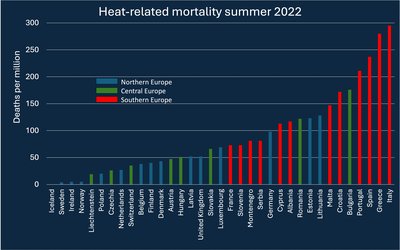Heat-related mortality is on the rise in Europe, while cold-related mortality is falling
July 12, 2021

Photo: Jonathan Molina (www.flickr.com)
The increase in the number of people in Europe dying from high temperatures will start to exceed the reduction of the number of people dying from cold spells in the second half of this century, especially in the Mediterranean. This was concluded from projections of the future effect of climate change on temperature-related mortality in 16 countries across Europe.
In this study, the relation between temperature and mortality was quantified from data on daily temperature and mortality in the period 1998–2012. These relations were subsequently used to transform the daily temperature simulations from four climate models for a historical period (1971–2005) and a scenario period (2006–2099) into projections of temperature-related mortality. Changes in temperature-related mortality were quantified between the 30-year reference (1976–2005), mid-century (2035–2064), and end-of-the-century (2070–2099) periods. Future projections were based on a low-end, moderate and high-end scenario of climate change.
Cold spells ten times more harmful than heat
Of all deaths registered in the observational period 1998–2012, 7.17% were attributed to extremely high and low (‘non-optimal’) temperatures. Cold spells contributed much more to these deaths than heat: 6.51% vs 0.65%, a difference by a factor of ten. Differences across countries are large: In Germany, 4.85% of all deaths were related to non-optimal temperatures, in Italy 9.87%.
Reversal in the second half of this century
In the course of this century, the percentage of the European population dying from cold temperatures will steadily decrease, while the percentage of the population dying from heat will increase. The latter increase will start to exceed the reduction of cold-weather related mortality in the second half of this century, especially in the Mediterranean. As a result, mortality in Europe related to non-optimal temperatures will start to increase by the end of the century in a moderate scenario of climate change, and already by the middle of the century in the high-end scenario of climate change.
Mitigation policies to slow down climate change would be especially beneficial in the Mediterranean. The benefits of less cold stress are much less there than the adverse effects of a higher vulnerability to heat.
Possibly an overestimation
The vulnerability to cold and heat may be less now than the data over the period 1998–2012 suggest. Adaptation to extreme temperatures already seems to reduce the vulnerability to cold and heat, and hence both the decrease in cold-related mortality and the increase in heat-related mortality may be smaller than the results above suggest.
Also, the European regions that will warm the most are also the regions that will dry faster. Heat stress not only results from high temperatures, but from high humidity as well. The projections above are based on a projected increase of high temperatures; an eventual decrease in humidity was not taken into account. Heat-related mortality in especially regions such as the Mediterranean may therefore be overestimated.
Source: Martínez-Solanas et al., 2021. Lancet Planetary Health 5: e446–54.








